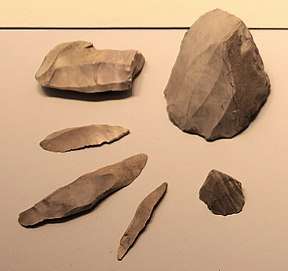Prepared-core technique
The prepared-core technique is means of producing stone tools by first preparing common stone cores into shapes that lend themselves to knapping off flakes that closely resemble the desired tool and require only minor touch-ups to be usable.
In contrast to earlier techniques, where cores themselves were the end product shaped and trimmed down by removal of flakes, in prepared-core technique large flakes are the product and the core is used to produce them. This shift made it faster and more resource-efficient, as multiple tools could be struck from a single piece of starting material.[1]
References
- "Middle Paleolithic Tool Technologies". University of California Santa Barbara, Department of Anthropology. Retrieved 16 September 2017.
Bibliography
- Bringmans, P.M.M.A., Vermeersch, P.M., Gullentops, F., Groenendijk, A.J., Meijs, E.P.M., de Warrimont, J.-P. & Cordy, J.-M. 2003. Preliminary Excavation Report on the Middle Palaeolithic Valley Settlements at Veldwezelt-Hezerwater (prov. of Limburg). Archeologie in Vlaanderen - Archaeology in Flanders 1999/2000 VII: 9-30.
- Bringmans, P.M.M.A., Vermeersch, P.M., Groenendijk, A.J., Meijs, E.P.M., de Warrimont, J.-P. & Gullentops, F. 2004. The Late Saalian Middle Palaeolithic "Lower-Sites" at Veldwezelt-Hezerwater (Limburg - Belgium). In: Le Secrétariat du Congrès (eds), Acts of the XIVth UISPP Congress, University of Liège, Belgium. September 2-8, 2001. Section 5: The Middle Palaeolithic. Oxford. British Archaeological Reports (BAR) International Series 1239: 187-195.
This article is issued from Wikipedia. The text is licensed under Creative Commons - Attribution - Sharealike. Additional terms may apply for the media files.
.jpg)
